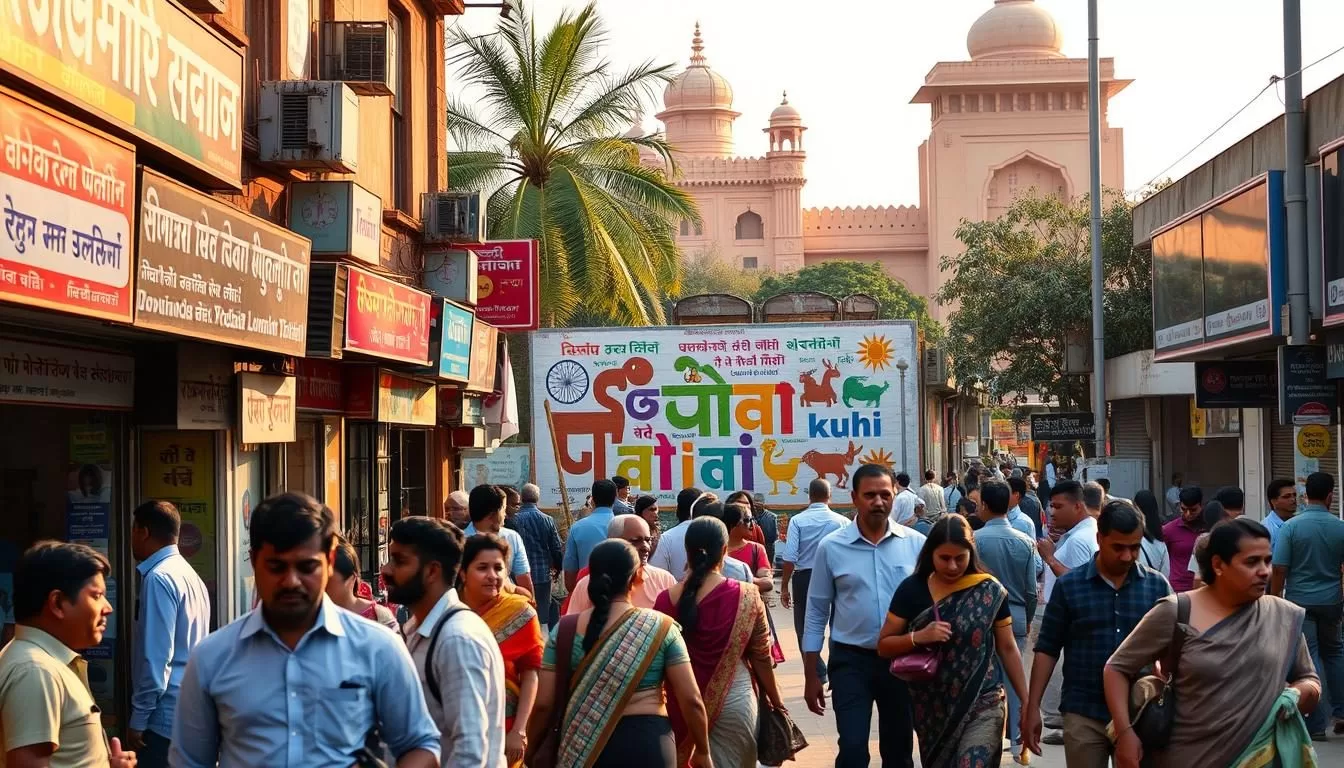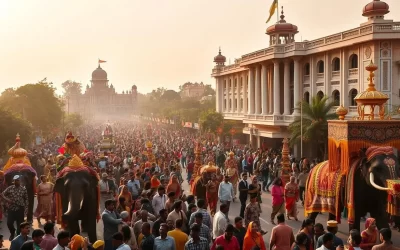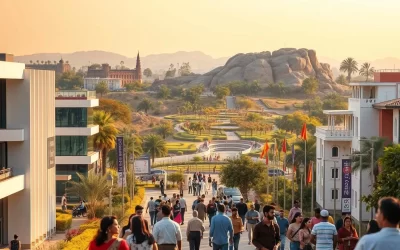You might be curious about the languages spoken in Chandigarh, a city that serves as the capital for both Punjab and Haryana states in northern India. With a population of over 1 million, according to the 2011 census, Chandigarh presents a fascinating case of linguistic diversity.
As you explore this union territory, you’ll find that English is the official language, used in government and educational institutions. However, the majority of the population speaks Hindi, with a significant percentage also speaking Punjabi. The language demographics have shifted over time, with Hindi gaining more speakers while Punjabi usage has proportionally declined.
This shift highlights the complex linguistic landscape of Chandigarh, making it a unique administrative region with a rich cultural heritage.
The Linguistic Landscape of Chandigarh
As a city that was meticulously planned post-independence, Chandigarh’s linguistic diversity is a reflection of its cultural and demographic makeup. The city’s unique position as a union territory serving as the capital for both Punjab and Haryana has contributed significantly to its linguistic landscape.
Geographic and Demographic Overview
Chandigarh is strategically located at the foothills of the Shivalik range, bordering both Punjab and Haryana. This geographic positioning has played a crucial role in shaping the city’s linguistic influences. The “tri-city” metropolitan area, which includes Chandigarh, Panchkula in Haryana, and Mohali in Punjab, has a combined population of over 1,611,770. This demographic statistic highlights the city’s significance as a cultural and administrative hub.
The city’s population is diverse, with residents from various linguistic backgrounds across India. Chandigarh’s role as an administrative center has attracted people from different parts of the country, contributing to its linguistic diversity. The city’s planned development has ensured that it remains a melting pot of cultures, with a significant impact on its language environment.
Chandigarh as a Planned City with Diverse Linguistic Influences
Chandigarh is one of the earliest planned cities in post-independence India, known internationally for its architecture and urban design. The master plan of the city was prepared by the renowned Swiss-French architect Le Corbusier. This planned development has had a profound impact on the city’s linguistic composition, creating a more diverse language environment than many traditional cities.
The city’s status as a significant government and educational hub has attracted residents from various linguistic backgrounds. As a result, Chandigarh has become a melting pot of languages, with a unique linguistic ecosystem that is influenced by the “tri-city” metropolitan area. The presence of various educational institutions has also contributed to the city’s linguistic diversity, making it an interesting case study for language dynamics.
You can observe how the carefully planned development of Chandigarh has influenced its linguistic composition, creating a diverse language environment. The city’s role as an administrative center and its demographic makeup have shaped its linguistic diversity, making it a fascinating example of how urban planning can impact language use.
English: The Sole Official Language of Chandigarh
As you explore the linguistic landscape of Chandigarh, you’ll discover that English holds a unique position as the sole official language. This distinction is noteworthy, especially considering the diverse linguistic demographics of the region. Understanding the role of English in Chandigarh involves examining its legal status, historical context, and practical applications in administration and official documentation.
Legal Status and Constitutional Provisions
The legal status of English as the official language of Chandigarh is rooted in the Constitution of India. According to the Constitution, states and union territories in India have the autonomy to choose their own official language(s) through legislation. India has two Official Languages at the national level: Hindi and English. Additionally, the Eighth Schedule to the Constitution recognizes 22 Scheduled Languages. Chandigarh, as a union territory, has chosen to adopt English as its sole official language, a decision that reflects its unique administrative and historical context.
This constitutional provision allows Chandigarh to maintain English as the primary language for official purposes, despite other languages like Hindi and Punjabi being more widely spoken among its residents. The choice of English as the official language has significant implications for governance, legal proceedings, and public administration in the territory.
Historical Context Behind English as the Official Language
The historical context behind English becoming the administrative language of Chandigarh is closely tied to the city’s planned development as a modern urban center after India’s independence. As the capital for both Punjab and Haryana, Chandigarh was designed to be a symbol of modernity and progress. English, being a neutral language in the regional linguistic politics, was a practical choice for official purposes.
The city’s status as a union territory, directly administered by the central government, further reinforced the use of English in official capacities. This decision was also influenced by the need for a common language that could facilitate communication between different linguistic groups within the territory and with the national government.
Usage in Administration and Official Documentation
In Chandigarh, English is used extensively in administration and official documentation. Government communications, administrative proceedings, and legal documents are all primarily conducted in English. This includes the functioning of the judicial system, where English is the predominant language used in courts and legal proceedings.
The use of English in official capacities extends to education administration and other government departments. This ensures a uniform language for official affairs, facilitating the smooth operation of government services and public administration in the union territory.
By adopting English as its sole official language, Chandigarh has created a unique linguistic environment that serves its specific administrative and historical needs. As you continue to explore the linguistic landscape of Chandigarh, you’ll gain a deeper understanding of how this decision impacts various aspects of life and governance in the territory.
Hindi: The Most Widely Spoken Language
As you explore the linguistic landscape of Chandigarh, you’ll find that Hindi stands out as the most widely spoken language. According to the 2011 census, a significant majority of the population, approximately 67.76%, speaks Hindi. This makes Hindi not only the most widely spoken language but also a crucial part of the city’s cultural fabric.
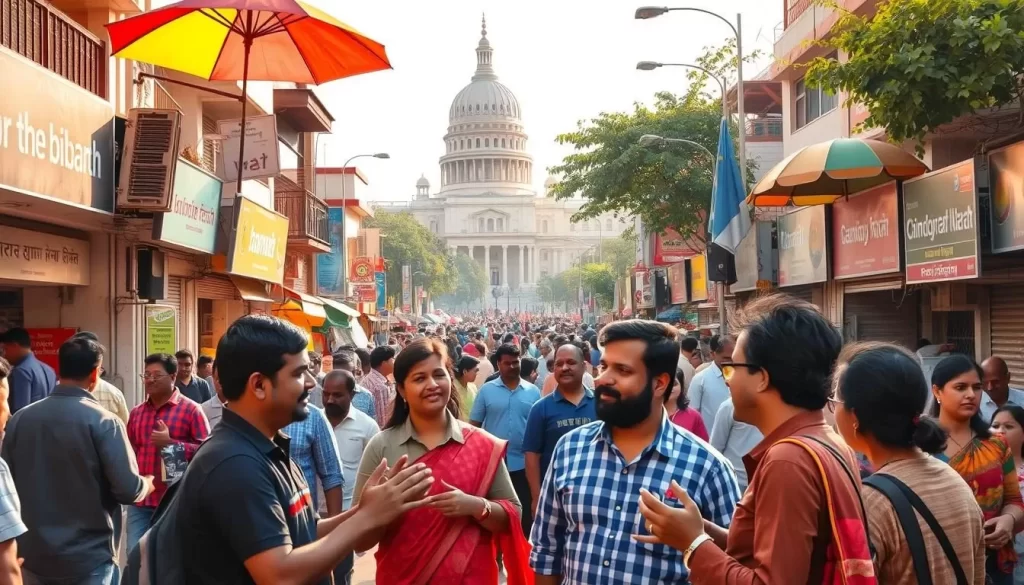
Demographic Distribution of Hindi Speakers
The demographic distribution of Hindi speakers in Chandigarh reveals interesting trends. Over the years, there has been a notable increase in the percentage of Hindi speakers. From 51% in 1981 to nearly 78% in 2011, the growth indicates a significant shift towards Hindi as the preferred language of communication.
You can observe this trend in the demographic breakdown:
| Year | Percentage of Hindi Speakers |
|---|---|
| 1981 | 51% |
| 2011 | 78% |
Dialects and Variations of Hindi in Chandigarh
Hindi spoken in Chandigarh is not homogeneous; it encompasses various dialects and regional variations. These variations reflect the diverse origins of the Hindi-speaking population, including migrants from different parts of northern and central India.
The dialects and variations contribute to the rich linguistic diversity of the city, making Hindi a vibrant and dynamic language in the region.
Cultural Significance and Media Presence
Hindi plays a vital role in the cultural and social life of Chandigarh. It is the language of entertainment, social interactions, and community events. The media presence of Hindi is evident in newspapers, magazines, television channels, radio stations, and digital media platforms.
The widespread use of Hindi in various forms of media not only caters to the linguistic preferences of the population but also reinforces its position as a lingua franca in the city.
You can see the impact of Hindi in various aspects of Chandigarh’s daily life, from the entertainment industry to social gatherings, highlighting its significance in fostering community and cultural identity.
Punjabi: The Regional Language with Strong Cultural Ties
You might be surprised to learn how Punjabi, spoken by 22.02% of the population, influences life in Chandigarh. This significant presence is rooted in the city’s history and its connection to the Punjab region.
Historical Connection to Punjab
Chandigarh was carved out from Punjabi-speaking villages to create a new capital city, establishing a deep historical connection between the city and the Punjab region. This heritage continues to influence the cultural and linguistic landscape of Chandigarh.
The historical ties are evident in the architectural styles, cultural festivals, and linguistic practices that reflect Punjabi traditions. Understanding this connection is crucial to appreciating the role of Punjabi in Chandigarh today.
Current Status and Speaker Demographics
According to the 2011 Census of India, Punjabi is spoken by 22.02% of Chandigarh’s population. This represents a decline from 36% in 1981, indicating a shift in language demographics over the years.
| Year | Percentage of Punjabi Speakers |
|---|---|
| 1981 | 36% |
| 2011 | 22.02% |
The distribution of Punjabi speakers across different sectors and neighborhoods of Chandigarh varies, with some areas having a higher concentration of Punjabi-speaking populations. This variation reflects the complex demographic makeup of the city.
Punjabi Literature and Cultural Expression
Punjabi literature and arts continue to thrive in Chandigarh, with notable poets, writers, and cultural institutions contributing to the city’s vibrant cultural scene. The language plays a significant role in music, festivals, and local traditions, maintaining its cultural significance despite its minority status.
Government schools in Chandigarh use English, Hindi, and Punjabi textbooks, ensuring that Punjabi maintains its presence in education. This availability of educational resources in Punjabi supports the language’s continued relevance in the city.
The complex relationship between Chandigarh’s role as Punjab’s capital and the relatively small percentage of Punjabi speakers among its residents highlights the city’s unique linguistic dynamics. As you explore Chandigarh, you’ll find that Punjabi is an integral part of the city’s identity, reflecting its history, culture, and ongoing evolution.
Other Significant Languages in Chandigarh
The linguistic diversity of Chandigarh extends far beyond its primary languages, encompassing a wide range of other significant languages. As a union territory serving as the capital for both Punjab and Haryana, Chandigarh attracts people from various linguistic backgrounds, contributing to its multilingual environment.
According to the 2011 census, besides Hindi (67.76%) and Punjabi (22.02%), other languages spoken in Chandigarh include Bhojpuri, Haryanvi, Urdu, Pahari, Nepali, Bengali, and Tamil. Let’s explore these languages and their significance in the region.
Bhojpuri and Its Speakers
Bhojpuri, spoken by 2.27% of Chandigarh’s population, is one of the significant minority languages in the region. Speakers of Bhojpuri have migrated to Chandigarh from the Bhojpuri-speaking regions of Bihar and Uttar Pradesh. They have maintained their linguistic and cultural identity through community gatherings and cultural events.
Many Bhojpuri speakers have integrated into Chandigarh’s society while preserving their mother tongue. The language is often used in domestic settings and during cultural festivals, contributing to the city’s linguistic diversity.
Haryanvi Influence in the Region
Haryanvi, with 1.06% of speakers, is another important language in Chandigarh. As the capital of Haryana, Chandigarh has a significant number of Haryanvi speakers who have moved to the city for administrative, educational, and professional reasons.
The presence of Haryanvi in Chandigarh reflects the city’s connection to its neighboring state. Haryanvi is often used in informal settings and is an essential part of the cultural identity of its speakers in the city.
Urdu and Its Historical Significance
Urdu, spoken by 1% of the population, holds historical significance in Chandigarh. The language has a rich cultural heritage in the region, with many literary and cultural contributions.
Although the number of Urdu speakers is relatively small, the language continues to be an essential part of certain communities in Chandigarh. Urdu is often used in cultural events and literary gatherings, preserving its historical importance.
Minority Languages: Pahari, Nepali, Bengali, and Tamil
Several other minority languages are spoken in Chandigarh, including Pahari (0.93%), Nepali (0.62%), Bengali (0.59%), and Tamil (0.53%). These languages reflect the city’s diverse population and its role as an educational and administrative center.
| Language | Percentage of Speakers |
|---|---|
| Pahari | 0.93% |
| Nepali | 0.62% |
| Bengali | 0.59% |
| Tamil | 0.53% |
These minority languages are often maintained through community efforts, cultural events, and family ties. They contribute to the rich linguistic mosaic of Chandigarh, making it a unique cultural hub.
Chandigarh (UT), India: Official and Widely Spoken Languages in Education
Chandigarh’s educational system reflects the territory’s rich linguistic heritage. As a union territory serving as the capital for both Punjab and Haryana, Chandigarh’s language policies in education are particularly noteworthy. The city’s educational institutions navigate a complex linguistic terrain, balancing the official language with widely spoken languages.
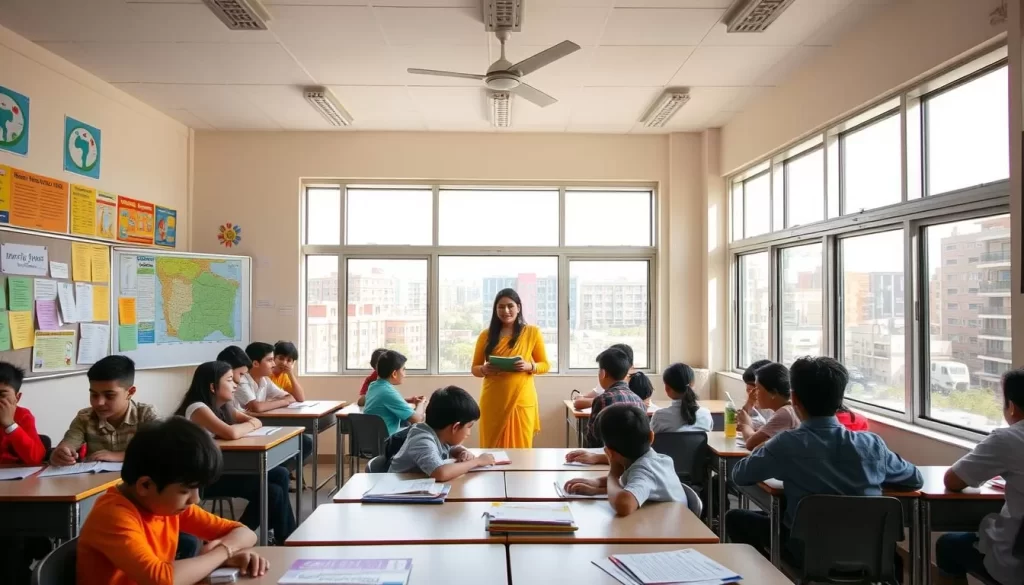
Medium of Instruction in Schools and Universities
In Chandigarh, English is the primary medium of instruction in many schools and higher education institutions, reflecting its status as the official language. This is particularly true for private schools and institutions, where English is used almost exclusively. Government schools, however, offer education in English, Hindi, and Punjabi, catering to the diverse linguistic population.
Panjab University, one of the significant educational institutions in Chandigarh, offers a range of programs with English as the primary medium of instruction. The university also has departments dedicated to the study of various languages, including Hindi and Punjabi, promoting linguistic diversity.
Language Curriculum and Policies
The language curriculum in Chandigarh’s schools is designed to be inclusive of the territory’s linguistic diversity. Hindi and Punjabi are taught as subjects in many schools, with some institutions offering them as optional mediums of instruction. This approach helps students maintain proficiency in their mother tongue while gaining education in the official language.
Language policies in Chandigarh’s education system aim to strike a balance between promoting the official language and preserving regional languages. This balance is crucial for maintaining cultural identity while ensuring students are proficient in the language used in administration and higher education.
Multilingual Education Initiatives
Chandigarh has seen innovative multilingual education initiatives aimed at preserving linguistic diversity while preparing students for a globalized world. These initiatives include bilingual education programs and language immersion courses that help students become proficient in multiple languages.
Such programs not only enhance language proficiency but also promote cultural understanding and exchange. By incorporating multiple languages into the curriculum, Chandigarh’s educational institutions are fostering a generation of multilingual individuals equipped to thrive in diverse environments.
In conclusion, Chandigarh’s educational landscape is characterized by a thoughtful integration of languages, reflecting the territory’s linguistic diversity. The city’s approach to language education offers valuable insights into managing multilingualism in educational settings.
Language Demographics: Trends and Changes
The linguistic composition of Chandigarh has evolved substantially, as revealed by census data from 1981 to 2011. You can gain valuable insights into the changing language demographics by examining the trends and shifts in language usage over these three decades.
Census Data Analysis
A detailed analysis of the census data from 1981 to 2011 shows significant changes in the linguistic landscape of Chandigarh. According to the data, the percentage of Punjabi speakers has fallen from 36% in 1981 to 22% in 2011, while that of Hindi speakers has increased from 51% to 78%.
| Language | 1981 (%) | 2011 (%) |
|---|---|---|
| Hindi | 51% | 67.76% |
| Punjabi | 36% | 22.02% |
| Bhojpuri | – | 2.27% |
| Haryanvi | – | 1.06% |
| Urdu | – | 1% |
The data indicates a significant shift in language demographics, with Hindi becoming the dominant language. You can observe that the census data provides a comprehensive overview of the linguistic changes in Chandigarh.
Shifting Patterns in Language Usage
The shift in language demographics can be attributed to various factors, including demographic changes, urbanization, and migration patterns. You may find it interesting to note that the increase in Hindi speakers corresponds with the urbanization and economic development of Chandigarh.
As Chandigarh continues to grow as a union territory, understanding these language trends is crucial. You can see that the linguistic landscape is not static and is influenced by various socio-economic factors.
The analysis of language demographics in Chandigarh highlights the importance of considering both the historical context and current trends. You can gain a deeper understanding of the complex linguistic dynamics at play by examining the census data and shifting patterns in language usage.
Linguistic Policies and Government Initiatives
As you explore the linguistic landscape of Chandigarh, you’ll discover the intricate policies governing language use in this union territory. The administration’s approach to language is shaped by Chandigarh’s status as a union territory, directly under the central government’s jurisdiction.
Union Territory Administration’s Approach to Languages
The Union Territory Administration of Chandigarh has adopted a multifaceted approach to managing languages within the territory. English is recognized as the sole official language for administrative purposes, in line with the Constitution of India, which allows states and union territories to choose their official languages through legislation.
Key aspects of the administration’s language policy include:
- Maintaining English as the primary language for official communication
- Promoting Hindi and other regional languages through cultural and educational initiatives
- Supporting linguistic diversity by accommodating various languages in public services and cultural events
Language Promotion and Preservation Efforts
The government of Chandigarh has initiated several programs aimed at promoting and preserving linguistic diversity. These efforts include supporting cultural events that celebrate different languages, incorporating regional languages into the educational curriculum, and providing language training for government officials.
| Language | Promotion Efforts | Preservation Initiatives |
|---|---|---|
| Hindi | Inclusion in school curriculum, cultural events | Language documentation, literature promotion |
| Punjabi | Cultural festivals, language classes | Support for Punjabi literature and media |
| Minority Languages | Community events, language documentation | Language preservation through education and media |
Challenges in Policy Implementation
Despite these efforts, the implementation of linguistic policies in Chandigarh faces several challenges. Resource constraints, competing priorities, and political sensitivities can hinder the effective execution of language policies. Balancing the promotion of official languages with the preservation of minority languages is a complex task that requires careful planning and coordination among various stakeholders.
By understanding these challenges and the administration’s approach to language, you can gain insights into the complexities of managing linguistic diversity in a multicultural urban setting like Chandigarh.
Multilingualism in Chandigarh’s Public Spaces
You’ll observe that Chandigarh’s public spaces are characterized by a rich multilingualism, influenced by its official language, English, and the widely spoken languages, Hindi and Punjabi. This linguistic diversity is a reflection of the city’s cultural landscape and its status as a union territory.
Signage and Public Information
The city’s signage and public information systems are crucial in understanding how multilingualism is managed in public spaces. Official signage, including government notices and public health information, typically features English as the primary language, followed by Hindi. Punjabi is also represented, albeit to a lesser extent.
For instance, a study of public signage in Chandigarh revealed that out of 100 signs observed, 80 were in English and Hindi, 15 included Punjabi alongside English and Hindi, and 5 were exclusively in English.
| Language | Number of Signs | Percentage |
|---|---|---|
| English & Hindi | 80 | 80% |
| English, Hindi, & Punjabi | 15 | 15% |
| English Only | 5 | 5% |
Transportation and Public Services
Chandigarh’s transportation systems, including bus services and auto-rickshaws, operate in a multilingual environment. While English and Hindi are predominantly used for announcements and signage, there’s a growing recognition of the need to accommodate Punjabi speakers as well.
Public services, such as hospitals and government offices, also reflect this multilingualism. For example, many hospital staff are encouraged to learn basic phrases in Hindi and Punjabi to better serve the local population.
Commercial Establishments and Markets
Commercial establishments in Chandigarh, from shopping malls to local markets, display a varied linguistic landscape. While English is commonly used in upscale establishments, Hindi and Punjabi are more prevalent in local markets and among street vendors.
This blend of languages in commercial spaces not only reflects the city’s demographic diversity but also caters to the linguistic preferences of its clientele.
As you can see, Chandigarh’s public spaces are a vibrant reflection of its multilingual identity, with various languages playing significant roles in different contexts.
Media and Entertainment: Language Preferences
As you explore the media landscape of Chandigarh, you’ll discover a diverse array of language preferences. The city’s media and entertainment sector caters to a multilingual population, offering content in various languages.
Print Media in Multiple Languages
Chandigarh’s print media ecosystem is vibrant, with newspapers and magazines available in Hindi, Punjabi, English, and other languages. Hindi dominates the print media landscape, reflecting its status as the most widely spoken language in the city, with 67.76% of the population speaking it.
Punjabi, spoken by 22.02% of the population, also has a significant presence in print media. English, being the official language, is widely used in publications, especially those catering to the city’s educated elite.
Television and Radio Broadcasting
Television and radio broadcasting in and around Chandigarh offer a mix of local and national channels. Language preferences in broadcasting tend to mirror the linguistic demographics of the city, with a strong presence of Hindi and Punjabi channels.
Local cable networks often broadcast content in multiple languages, catering to the diverse linguistic preferences of their viewers.
Digital Media and Social Platforms
The rise of digital media and social platforms has significantly influenced language use in Chandigarh. Online content creation and consumption have opened up new avenues for minority languages to find expression.
Social media platforms, in particular, have become important spaces for linguistic diversity, allowing users to engage with content in their preferred languages.
Cinema and Performing Arts
Chandigarh’s entertainment preferences are also reflected in its cinema and performing arts scene. While Bollywood films (primarily in Hindi) are widely popular, there is also a significant audience for Punjabi cinema.
The city’s cultural events and festivals often feature performances in multiple languages, showcasing its rich linguistic heritage.
Language and Cultural Identity in Chandigarh
As you explore Chandigarh, you’ll discover how language plays a crucial role in shaping the city’s cultural identity. The city’s diverse population, with Hindi (67.76%) and Punjabi (22.02%) as the most widely spoken languages, creates a unique cultural landscape.
Linguistic Influences on Local Culture
The local culture in Chandigarh is a blend of various linguistic traditions. You can see this in the city’s art, literature, and daily life. For instance, the city’s Punjabi heritage is reflected in its vibrant folk music and dance, while Hindi influences are evident in the city’s literary events and festivals.
The language spoken at home often determines the cultural practices and traditions that are passed down through generations. In Chandigarh, the mix of languages has resulted in a distinct cultural identity that is different from the neighboring states, including the Indian states of Punjab and Haryana.
Festivals and Celebrations Across Language Communities
Chandigarh hosts various cultural festivals and celebrations throughout the year, reflecting its linguistic diversity. You can experience the city’s cultural richness by attending festivals like the Punjabi harvest festival of Baisakhi or Hindi literary events.
These festivals not only showcase the city’s cultural diversity but also highlight the importance of language in shaping cultural identity. For many residents, their mother tongue is closely tied to their cultural heritage and is a source of pride.
Language as a Marker of Identity
In Chandigarh, language serves as a significant marker of identity, influencing social networks, marriage patterns, and community formation. You may notice how people often identify themselves with specific language communities, which can affect their social interactions and cultural practices.
The city’s linguistic landscape is complex, with residents often navigating multiple linguistic identities. This complexity is a reflection of Chandigarh’s status as a cosmopolitan city, attracting people from different parts of the world and Indian states. As you read this article, you’ll gain a deeper understanding of how language shapes the identity of Chandigarh’s residents.
Language in Business and Economic Sectors
As you explore the business landscape of Chandigarh, you’ll notice how language plays a crucial role in shaping economic activities. The city’s economic prosperity, reflected in its high per capita income and Human Development Index, is closely tied to its linguistic profile.
Chandigarh’s status as a union territory with English as the sole official language significantly influences business communications. This has a direct impact on various sectors, including corporate, tourism, and IT.
Corporate Communication Practices
In the corporate world of Chandigarh, English dominates as the primary language for business communications. Companies operating in the city predominantly use English for official documents, meetings, and presentations. This preference is driven by the city’s status as a hub for multinational corporations and the need for clear, professional communication.
Many businesses in Chandigarh also recognize the importance of other languages, particularly Hindi and Punjabi, for customer-facing interactions. This multilingual approach helps companies connect with a broader client base and navigate the local market effectively.

Tourism and Hospitality Industry Language Needs
The tourism and hospitality industry in Chandigarh faces unique language challenges due to the diverse linguistic backgrounds of visitors. To cater to this diverse clientele, hotels, restaurants, and tourist information centers often employ staff proficient in multiple languages.
Signage, menus, and informational materials in tourist areas frequently appear in English, Hindi, and sometimes Punjabi. This multilingual approach helps ensure that visitors can navigate and enjoy the city’s attractions with ease.
IT Sector and Language Requirements
Chandigarh’s growing IT sector has specific language requirements, primarily driven by the need for effective communication with global clients. English remains the dominant language in this sector, used for software development, client interactions, and project documentation.
However, as the IT industry in Chandigarh continues to evolve, there’s a growing recognition of the importance of other languages, particularly for serving local markets and expanding into new regional markets.
As Chandigarh continues to develop its technology infrastructure and attract more tech companies, the demand for professionals with strong language skills, particularly in English, is likely to remain high.
Code-Switching and Language Mixing Phenomena
As you explore the linguistic dynamics of Chandigarh, you’ll discover that code-switching is an integral part of everyday conversations. This phenomenon, where speakers alternate between two or more languages within a single conversation, is a hallmark of the city’s multilingual identity.
Common Patterns of Language Mixing in Daily Conversation
In Chandigarh, code-switching commonly occurs between Hindi, Punjabi, and English. For instance, a conversation might start in Hindi, switch to English for a specific term or phrase, and then revert to Punjabi to convey a cultural nuance. This mixing of languages is not random; it follows certain patterns that are influenced by the context of the conversation, the topic being discussed, and the social dynamics between the speakers.
One common pattern is the use of English for technical or professional terms, while using Hindi or Punjabi for everyday expressions. For example, in a discussion about work, someone might say, “Mujhe apna project kal submit karna hai” (“I have to submit my project tomorrow”), combining Hindi with English technical terms.
| Language Combination | Example | Context |
|---|---|---|
| Hindi-English | “Mujhe apna project kal submit karna hai” | Professional/Work |
| Punjabi-Hindi | “Main kal bazar gaya si, par store band si” | Shopping/Everyday |
| English-Punjabi | “Let’s meet at the mall, fir chay peetange” | Social/Leisure |
Sociolinguistic Aspects of Code-Switching
The sociolinguistic aspects of code-switching in Chandigarh reveal that this practice is not just a matter of linguistic convenience but also carries social significance. Code-switching can be used to signal identity, convey social status, or establish rapport with the listener. For instance, switching to English might be seen as a marker of education or professional status, while using Punjabi might be a way to connect with cultural heritage.
Attitudes toward code-switching vary among different age groups and social classes in Chandigarh. Younger, educated individuals might code-switch more frequently, especially in professional or educational settings, while older generations might view it as a natural part of their linguistic repertoire.
Understanding code-switching in Chandigarh provides insights into the city’s linguistic and social fabric. It’s a dynamic phenomenon that reflects the city’s cultural diversity and the complex identities of its inhabitants.
Language Learning Resources and Institutions
You can find numerous language learning opportunities in Chandigarh, from formal education to community-based programs. The city’s high literacy rate of 86.77% and robust educational infrastructure create a fertile ground for language learning across different demographic groups.
Language Schools and Training Centers
Chandigarh is home to various language schools and training centers that offer courses in English, Hindi, Punjabi, and foreign languages. These institutions cater to diverse needs, from improving language proficiency for academic purposes to enhancing career opportunities. Many of these centers are equipped with modern teaching methodologies and experienced faculty, ensuring that learners receive quality education.
Some of these institutions also offer specialized courses, such as language for specific purposes, which can be particularly useful for individuals looking to improve their language skills for professional or business purposes.
University Departments and Research
Panjab University, located in Chandigarh, is a premier institution that offers a wide range of language courses through its various departments. The university’s language departments are involved in both teaching and research, providing students with a comprehensive understanding of languages and their cultural contexts.
The research initiatives at Panjab University and other higher education institutions in Chandigarh contribute significantly to the field of language studies, focusing on areas such as linguistic analysis, language teaching methodologies, and cultural studies.
Online and Community-Based Learning Opportunities
In addition to formal educational institutions, Chandigarh also offers community-based language learning opportunities. Cultural associations and community centers often provide language classes to preserve heritage languages and promote cultural heritage.
The growing role of online and digital resources in language learning is also evident in Chandigarh. Learners can access various language learning apps, websites, and virtual communities to supplement their language learning journey. These resources offer flexibility and a wide range of learning materials, catering to different learning styles and preferences.
Overall, Chandigarh’s language learning landscape is characterized by a mix of traditional educational institutions and modern digital resources, providing learners with a diverse range of options to achieve their language learning goals.
Future Linguistic Trends in Chandigarh
You can anticipate significant shifts in Chandigarh’s language demographics as the city continues to grow and develop. The linguistic landscape of Chandigarh has been changing over the years, and this trend is expected to continue into the future.
Projected Changes in Language Demographics
Historical data indicates a significant shift in language demographics in Chandigarh. For instance, the percentage of Punjabi speakers has fallen from 36% in 1981 to 22% in 2011, while that of Hindi speakers has increased from 51% to 78%. This trend suggests that the proportion of languages spoken in Chandigarh will continue to evolve.
Future projections indicate that Hindi is likely to maintain its dominance, while the proportion of Punjabi speakers may continue to decline. However, English is expected to remain a crucial part of the linguistic landscape, particularly in official and educational contexts.
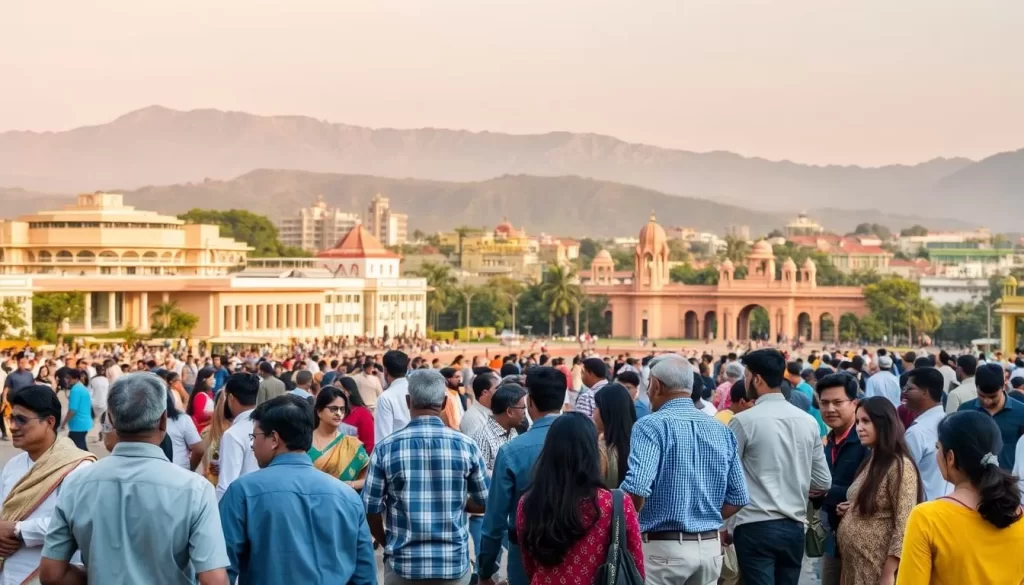
Impact of Migration and Urbanization
Migration and urbanization are key factors that will influence the linguistic trends in Chandigarh. As people move to the city for work and education, they bring with them their languages and dialects, contributing to the linguistic diversity.
The Chandigarh Capital Region is experiencing rapid urbanization, which is likely to impact language use and attitudes. As the city expands, there may be increased interactions among people from different linguistic backgrounds, potentially leading to the emergence of new linguistic patterns.
Digital Technology and Language Evolution
Digital technology and social media are playing an increasingly important role in shaping language use in Chandigarh. The rise of digital platforms has led to the creation of new hybrid forms of communication, blending elements from different languages.
As technology continues to evolve, it is likely to have a profound impact on the linguistic landscape of Chandigarh. The increasing use of digital media may lead to new forms of language expression and potentially influence language learning priorities among the city’s residents.
Looking ahead to the coming years, say by April 2025, we can expect to see further changes in how language is used in Chandigarh, driven by technological advancements and changing demographics.
Conclusion
As we reflect on the language landscape of Chandigarh, we see a city where multiple languages coexist, influencing one another and shaping the city’s cultural heritage.
Chandigarh, a multilingual union territory, has English as its sole official language. According to the 2011 Census of India, Hindi is spoken by 67.76% of the population, followed by Punjabi at 22.02%. The percentage of Punjabi speakers has fallen from 36% in 1981 to 22% in 2011, while that of Hindi speakers has increased from 51% to 67.76%.
The city’s linguistic diversity is a reflection of its planned development and its role as a capital for two states, Punjab and Himachal Pradesh. This unique history has contributed to the complex language dynamics, with language use varying across different contexts and communities.
The official language status of English in Chandigarh contrasts with the actual language usage patterns among residents. While English is used in administration and official documentation, Hindi and Punjabi are widely spoken in daily life.
Chandigarh’s language situation has implications for cultural identity, education, governance, and social cohesion. Understanding and appreciating this linguistic diversity is crucial for fostering a sense of community and promoting social harmony.
Looking ahead, it’s likely that Chandigarh’s language demographics will continue to evolve, influenced by factors such as migration and urbanization. As the city’s population becomes increasingly diverse, its languages will continue to shape its cultural heritage and contemporary identity.
In conclusion, Chandigarh’s linguistic landscape is characterized by a rich diversity of languages, with English serving as the official language. As we move forward, it’s essential to recognize the importance of this linguistic diversity and its implications for the city’s development and character, not just in Chandigarh but also in the broader context of union territories and states in India, including Jammu and Kashmir.
The above is subject to change.
Check back often to TRAVEL.COM for the latest travel tips and deals.
